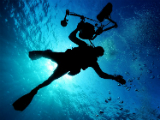
Author: Paolo Casari, Research Assistant Professor, IMDEA Networks Institute
Research activities in networks and future wireless communications are not merely restricted to on-land scenarios. Underwater acoustic networking is an emerging research area that is attracting more and more attention. Paolo Casari, Assistant Research Professor and leader of the Ubiquitous Wireless Networks Group at IMDEA Networks gives us a brief introduction to some of the aspects of this fascinating research area.

The quest towards ubiquitous wireless communications in every environment faces a grand challenge when moving under the surface of seas and oceans. In fact, the wireless radio communication technologies we are used to on land find little application under water, as radio waves are strongly attenuated, and can support communications only over distances up to a few meters. Still, the interest towards wireless communications in the oceans is very large both for societal reasons (efficient underwater communications and networks could support wide-area monitoring, disaster relief, distress support, etc.) and for economic reasons (ubiquitous cabled underwater networks are not feasible due to the extremely high cost of waterproof underwater cables).
For this reason, over the last 10-15 years, wireless underwater communications have been developed using sound to communicate over long distances. Yet, sound-based communications are very resource-constrained, and at the same time quite slow with respect to terrestrial radio communications. Low transmission rates (on the order of a few kilobits per second), a propagation speed of only about 1500 m/s, much lower than the propagation speed of radio waves in the air (about 300000 km/s), and high energy consumption with respect to terrestrial radio, make it very important to correctly organize communications effectively. Among other things, this means that transmissions must be received correctly by their intended destinations and should not cause destructive interference to one another. When that happens, we speak of a “collision”, meaning that two or more superimposed signals which were received simultaneously, could not be told apart from one another, and thus some or all of them were lost.
One of the most common sources of collisions in underwater networks is the so-called near-far effect. This phenomenon occurs when two transmitters send a signal to the same receiver from very different distances: the signal from the closer transmitter will be much less attenuated, and therefore it will overshadow, or jam, the typically weaker signal coming from the farther transmitter. This scenario is very common in underwater networks. In fact, the attenuation per unit distance traveled by an acoustic signal is quite large, and therefore almost every typical network deployment is likely to be affected by at least one instance of the near-far effect. The typical approach is to mitigate or avoid near-far events completely by designing medium access control (MAC) protocols so as to ensure that the collision of a signal by a “near” node on the transmission by a “far” node can be avoided or limited.
The purpose of the research being carried out by the Ubiquitous Wireless Networks Group at IMDEA Networks in collaboration with the SIGNET group of the University of Padova, Italy, is to reverse this paradigm by making the near-far effect a resource rather than an impairment. The collaboration between the two groups has been focusing on the design of two MAC protocols, one based on transmission scheduling (or in other words on the decision of which transceivers should send their signals at any given time) and another one based on preliminary message exchanges to establish point-to-point connections (a procedure also known as handshaking).
After a “wet” test of the protocols with underwater communication equipment in a tank (Figure 1), the five communication-capable units (or nodes) shown in the figure were deployed in the Garda Lake, Italy, in the nearabouts of the town of Lazise, around mid-December 2015. In this way, a network of five nodes was formed. Two nodes were deployed near the shore thanks to the presence of piers (Figure 2), whereas three other nodes were introduced in the lake from two small fishing boats, (Figure 3 shows one of the boats with research engineer Filippo Campagnaro from the University of Padova monitoring the underwater traffic). Several other network topologies were tested over one full day of experiments. In particular, the nodes on board the fishing boats were moved in order to reproduce different occurrences of the near-far effect, for example, by getting them closer to some nodes and farther from other nodes, and thereby collect data concerning the performance of the designed protocol in several scenarios. The weather blessed the experiment with an overall beautiful and sunny day.
The experiments proved the effectiveness of the MAC protocols designed to exploit the near-far effect for better network performance in underwater networks. The collected data are currently being post-processed for inclusion in scientific papers.

Fig. 1: Realization of a wet test of the protocols with underwater communication equipment in a tank.

Fig. 2: Nodes deployed near the shore thanks to the presence of piers.

Fig. 3: Filippo Campagnaro from the University of Padova monitoring the underwater acoustic traffic.

